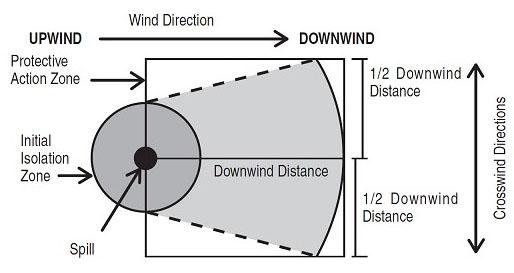
5 minute read
Annex G: Guidance on onsite response to pipeline incidents, derailments and marine incidents
Response to a pipeline incident
The Emergency Response Guidebook (ERG2016) [ERG, 2016] provides general instructions for responders to pipeline incidents. (Indications of pipeline ruptures are given on page 22.)
Advertisement
Safety of both the responder and the community is the top priority.
The responder should approach a pipeline incident from upwind, uphill, and upstream while using air monitoring equipment to detect for the presence of explosive and/or toxic levels of hazardous materials:
• always wear proper personal protective equipment; • never attempt to operate pipeline valves;
• never attempt to extinguish a flame before shutting off supply, as this can cause formation of explosive mixtures; and • do not enter a vapour cloud in an attempt to identify the product(s) involved. ERG 2016 tells responders to (see page 24): • identify the operator and, if possible, the product;
• notify the pipeline operator; • establish a command post;
• secure the site; and
• develop a plan to evacuate or shelter-inplace. ERG 2016 discusses factors to be considered in determining protective action distances for crude oil release from ruptured pipelines (see below).
Response to a derailment
The advice given in the case of a derailment would be similar to that given for a pipeline rupture except that the rail company would be notified. Information specific to derailments involving Bakken crude oil is given in a report by the NWAC [NWAC, 2015].
Response to a marine incident
Canadian response to marine oil spills is detailed in the Canadian National Oil Spill Preparedness and Response Regime [TC, 2012]. The Canadian Coast Guard (CCG) oversees the response to ship-source oil spills in Canadian waters. The onus for responding to pollution incidents is placed on the polluter who hires a response organization to do the clean-up. The four certified response organizations, based on geographical areas, are described in reference [TC, 2016]. The CCG monitors the polluter's efforts and steps-in to manage the response only if a polluter is unknown, unwilling, or unable to respond to an incident. The CCG can seek compensation for costs incurred when managing or monitoring the response to an incident.
Transport Canada guidelines for reporting incidents involving marine pollutants are given in reference TC, 2016 and regional contact numbers for reporting a marine pollution incident in reference CCG, 2015.
Initial isolation and protective action distances
The determination of protective action distances is best left to the incident response team (HAZMAT coordination/incident commander/industry expert). The Initial Isolation Zone defines an area SURROUNDING the incident in which persons may be exposed to dangerous (upwind) and life threatening (downwind) concentrations of material.
The Protective Action Zone defines an area DOWNWIND from the incident in which persons may become incapacitated and unable to take protective action and/or incur serious or irreversible health effects (see Figure G–1). The ERG 2016 provides general guidance on initial isolation zones and protective action zones.
Crude oil (UN 1267) is classified as a flammable liquid (Water-Immiscible). Guide 128 suggests that for large spills (greater than 208 litres) an initial downwind evacuation for at least 300 metres be considered. If a tank, rail car, or tank truck is involved in a fire, an isolation distance of 800 metres in all directions should be put in force and an initial evacuation for 800 metres in all directions considered.
Sour crude oil (UN 3494) is classified as a flammable liquid (Toxic). Guide 131 suggests that for a spill, the initial isolation distance and protective action distance given in ERG 2016 should be used (see Table G–1). It further states that if a tank, rail car, or tank truck is involved in a fire, an isolation distance of 800 metres in all directions be put in force and an initial evacuation for 800 metres in all directions be considered.
Table G–1: Initial Isolation Distances and Protective Action Distances for sour crude oil (UN 3494) spills [ERG2016]
SMALL SPILLS** (From a small package or small leak from a large package*) LARGE SPILLS** (From a large package or from many small packages)
Day (km) Night (km)
Day (km) Night (km)
60 0.5 0.7
* package = packaging plus contents ** Spills that involve releases of approximately 208 litres for liquids (55 US gallons) and 300 kg for solids (660 lbs) or less are considered Small Spills, while spills that involve greater quantities are considered Large Spills
The ERG 2016 notes that the following factors should be considered in determining protective action distances for crude oil release from ruptured pipelines (ERG, 2016): 1. type of crude oil (e.g., sour vs. sweet); 2. extent and type of spill (visual observations, e.g., geyser from ruptured pipe, slowly bubbling out of ground); 3. pressure and diameter of pipe; 4. timing of valve closure by utility (quickly for automated valves and longer for manually operated valves); 5. dissipation time of material in pipe once valves closed;
6. ability to conduct atmospheric monitoring and/or air sampling; 7. weather (wind direction, etc.) 8. local variables such as topography, population density, demographics, and fire suppression methods available;
9. nearby building construction material and density; and
10.natural and man-made barriers (highway). In addition to factors 1, 6, 7, 8, 9, and 10, the following factors would be considered in the case of a derailment:
• has a fire or explosion occurred or does it appear to be imminent; and
• the number of tank cars derailed and their condition (e.g., do the cars appear to be leaking)
References
Canadian Coast Guard (CCG, 2015) Report Marine
Pollution [http://www.ccggcc.gc.ca/eng/CCG/ER_Reporting_Incident]
Emergency Response Guidebook (ERG2016), U.S.
Department of Transportation, Pipelines and Hazardous
Materials Safety Administration, Transport Canada,
Secretariat of Transport and Communications Mexico. [https://www.tc.gc.ca/media/documents/tdgeng/EnglishERGPDF.pdf]
NW Area Committee Federal and State Spill Response
Agencies (NWAC) (2015) Bakken Crude Oil. [http://www.rrt10nwac.com/Files/FactSheets/15021306 4220.pdf]
Transport Canada (TC) (2012) National Oil Spill
Preparedness and Response Regime [http://www.tc.gc.ca/eng/marinesafety/oep-ersregime-menu-1780.htm]
Transport Canada (TC) (2016) Response Organizations. [http://www.tc.gc.ca/eng/marinesafety/oep-ersregime-ros-771.htm]





